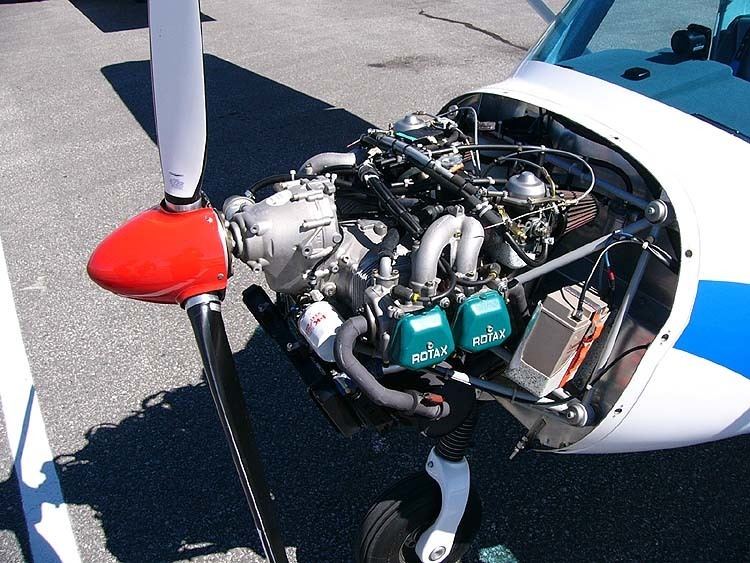 | ||
The Rotax 912 is a normally aspirated, air- and water-cooled, horizontally opposed four-cylinder, four-stroke, gear reduction-drive engine commonly used on certified aircraft, light sport aircraft, ultralight aircraft and unmanned aerial vehicles. Rotax produced its 50,000th 912-series engine in 2014.
Contents
Development
The original 80 hp (60 kW) 912 engine has a capacity of 1,211 cc (73.9 cu in) and a compression ratio of 9.1:1. The later 912S is enlarged to 1,352 cubic centimetres (82.5 cu in) and has a compression ratio of 10.4:1, yielding 100 hp (75 kW). The 912 A and F are used in certified aircraft, such as the Diamond DA20, which is quite popular in Europe. The 100 hp (75 kW) versions are used in many light sport aircraft, such as the Zenith STOL CH 701 and the Tecnam P2002 Sierra. The 80 hp (60 kW) versions are sufficient to power the new generation of efficient motorgliders, such as the Pipistrel Sinus and the Urban Air Lambada. It is also fitted to some light twins, such as the Tecnam P2006T.
The engine differs from conventional aircraft engines (such as the Lycoming O-235) in that it has air-cooled cylinders with liquid-cooled heads and uses a 2.43:1 gearbox (PSRU) to reduce the engine's relatively high 5,800 rpm shaft speed to a more conventional 2,400 rpm for the propeller. On the 912A, F and UL the standard reduction ratio is 2.27:1 with 2.43:1 optional. Lubrication is dry sump, and fuelling is via dual CV carburetors or fully redundant electronic fuel injection. The electronic fuel injected Rotax 912iS is a recent development. A further derivative, the 135 hp (101 kW) Rotax 915 iS was announced in July 2015.
Early 912 series engines have a shorter time between overhaul (TBO) than traditional engines, but are more fuel efficient than similarly sized engines, e.g., Continental O-200. Effective 14 December 2009, 912 engines have had their recommended Time Between Overhauls (TBO) raised from 1,200 hours to 1,500 hours, or 1,500 hours to 2,000 hours, depending on serial number. In addition to the lower fuel consumption they are certified to run on automotive fuel (mogas), further reducing running costs, especially in areas where leaded AVGAS is not readily available. The engines are popular in Europe and in United States Light Sport Category aircraft due to high power-to-weight ratio, low fuel costs and relatively quiet operation.
On 8 March 2012 the company displayed its 912 iS variant, a 100 hp (75 kW) version with fuel injection and an electronic engine management unit. The version weighs 63 kg (139 lb), which is 6 kg (13 lb) more than the standard 912S. The non-certified 912 iS targets the Light Sport and Experimental market and 912 iSc will be certified. Production started in March 2012 and the engine has a 2000-hour recommended time-between-overhaul to start.
On 1 April 2014 the company announced its new 912 iS Sport upgrade with greater power and torque and reduced fuel consumption.
Limitations
The manufacturer acknowledges the design limitations of this engine, warning pilots:
"Never fly the aircraft equipped with this engine at locations, airspeeds, altitudes, or other circumstances from which a successful no-power landing cannot be made, after sudden engine stoppage.
This engine is not suitable for acrobatics (inverted flight etc.). This engine shall not be used on rotorcrafts with an in-flight driven rotor (e.g. helicopters). It should be clearly understood that the choice, selection and use of this particular engine on any aircraft is at the sole discretion and responsibility of the aircraft manufacturer, assembler and owner/user.
Due to the varying designs, equipment and types of aircraft, BRP-Powertrain grants no warranty or representation on the suitability of its engine’s use on any particular aircraft. Further, BRP-Powertrain grants no warranty or representation of this engine’s suitability with any other part, components or system which may be selected by the aircraft manufacturer, assembler or user for aircraft application.
Non-compliance can result in serious injuries or death!
Unless correctly equipped to provide enough electrical power for night VFR (according latest requirement as e.g. ASTM), the ROTAX 912 UL/ULS/ULSFR is restricted to DAY VFR only.
Certain areas, altitudes and conditions present greater risk than others. The engine may require humidity or dust/sand preventative equipment, or additional maintenance may be required.
You should be aware that any engine may seize or stall at any time. This could lead to a crash landing and possible severe injury or death. For this reason, we recommend strict compliance with the maintenance and operation and any additional information which may be given to you by your dealer."
Variants
The engine is available in the following versions:
The # in the designation stands for:
- Shaft with flange for fixed pitch propeller, P.C.D. 100 mm
- Shaft with flange for fixed pitch propeller, P.C.D. 75 mm, P.C.D. 80 mm and P.C.D. 4 inches
- Shaft with flange for constant speed propeller P.C.D. 75 mm, P.C.D. 80 mm, P.C.D. 4 inches and drive for hydraulic governor for constant speed propeller
- Shaft with flange for fixed speed propeller P.C.D. 75 mm, P.C.D. 80 mm, P.C.D. 4 inches also can be fitted with an adaptor, drive and governor for a constant speed propeller.
